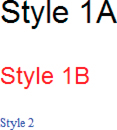Manipulação de folha de estilos HTML do ActionScriptAdobe AIR 1.0 e posterior Depois que o objeto HTMLLoader tiver despachado o evento complete, você poderá examinar e manipular estilos CSS na página. Por exemplo, considere o seguinte documento HTML simples: <html>
<style>
.style1A { font-family:Arial; font-size:12px }
.style1B { font-family:Arial; font-size:24px }
</style>
<style>
.style2 { font-family:Arial; font-size:12px }
</style>
<body>
<p class="style1A">
Style 1A
</p>
<p class="style1B">
Style 1B
</p>
<p class="style2">
Style 2
</p>
</body>
</html>
Depois que o objeto HTMLLoader carregar esse conteúdo, você poderá manipular os estilos CSS da página, através da matriz cssRules da matriz window.document.styleSheets, como mostrado a seguir: var html:HTMLLoader = new HTMLLoader( );
var urlReq:URLRequest = new URLRequest("test.html");
html.load(urlReq);
html.addEventListener(Event.COMPLETE, completeHandler);
function completeHandler(event:Event):void {
var styleSheet0:Object = html.window.document.styleSheets[0];
styleSheet0.cssRules[0].style.fontSize = "32px";
styleSheet0.cssRules[1].style.color = "#FF0000";
var styleSheet1:Object = html.window.document.styleSheets[1];
styleSheet1.cssRules[0].style.color = "blue";
styleSheet1.cssRules[0].style.font-family = "Monaco";
}
Esse código ajusta os estilos CSS para que o documento HTML resultante tenha a seguinte aparência:  Lembre-se de que esse código pode adicionar estilos à página após o objeto HTMLLoader despachar o evento complete. |

|